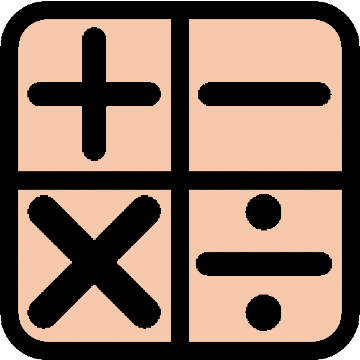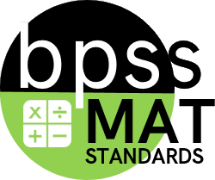MAT-12.NO.11

|
12th Grade (MAT) Targeted Standard
(NO) Number and Operations
Learners will develop a foundational understanding of the number system, operations, and computational fluency to create connections and solve problems within and across concepts.
|
MAT-12.NO.11 Represent addition, subtraction, multiplication, conjugation, powers, and roots of complex numbers geometrically on the complex and/or polar plane; use properties of this representation for computation.
 Proficiency Scale Proficiency Scale
Progressions
Addition and Subtraction
- MAT-01.NO.NBT.03 Add within 100 using a two-digit number and a one-digit number. Use concrete models, drawings, and strategies that reflect an understanding of place value.
- MAT-02.NO.NBT.03 Add within 100 using place value strategies and/or the relationship between addition and subtraction.
- MAT-01.NO.NBT.04 Subtract multiples of 10 within 100 using concrete models, drawings, and strategies that reflect an understanding of place value.
- MAT-01.NO.NBT.05 Mentally add or subtract 10 to or from a given two-digit number and explain the reasoning used.
- MAT-02.NO.NBT.04 Subtract within 100 using place value strategies and/or the relationship between addition and subtraction.
- MAT-02.NO.NBT.05 Mentally add or subtract 10 or 100 to or from a given number between 100 and 900.
- MAT-03.NO.NBT.03 Add and subtract within 1000 using place value strategies, algorithms, and/or the relationship between addition and subtraction.
- MAT-04.NO.NBT.04 Add and subtract multi-digit whole numbers to the one million place using strategies flexibly, including the algorithm.
- MAT-05.NO.NBT.05 Use concrete models, drawings, place value strategies, properties of operations, and/or relationships to add, subtract, and multiply decimals to hundredths.
- MAT-07.NO.O.01 Add, subtract, multiply, and divide integers using visual models and properties of operations in multi-step authentic and mathematical problems, including authentic problems.
- MAT-07.NO.O.02 Add, subtract, multiply, and divide non-negative fractions in multi-step problems, including authentic problems.
- MAT-07.NO.O.03 Add, subtract, multiply, and divide non-negative decimals to the hundredth place in multi-step problems using strategies or procedures, including authentic problems.
- MAT-08.NO.O.02 Add, subtract, multiply, and divide rational numbers using strategies or procedures.
- MAT-09.NO.02 Perform basic operations on simple radical expressions to write a simplified equivalent expression.
- MAT-09.AR.11 Add, subtract, and multiply polynomials.
- MAT-12.NO.03 Demonstrate that the sum or product of two rational numbers is rational; that the sum of a rational number and an irrational number is irrational, and that the product of a nonzero rational number and an irrational number is irrational.
- MAT-12.AR.13 Add, subtract, and multiply polynomials beyond quadratics. Understand that polynomials form a system comparable to the integers, namely, they are closed under the operations of addition, subtraction, and multiplication.
- MAT-12.NO.11 Represent addition, subtraction, multiplication, conjugation, powers, and roots of complex numbers geometrically on the complex and/or polar plane; use properties of this representation for computation.
- MAT-12.NO.17 Add and subtract vectors. Represent vector subtraction graphically by connecting the tips of the appropriate order and using the components to perform vector subtraction.
- MAT-12.NO.19 Represent data in a matrix. Perform operations (i.e., addition, subtraction, multiplication) on matrices of appropriate dimensions to solve problems and in context. Know that matrix multiplication is not commutative.
Multiplication and Division
- MAT-03.NO.NBT.04 Multiply one-digit whole numbers by multiples of 10 within 100.
- MAT-04.NO.NBT.05 Multiply a whole number up to four digits by a one-digit whole number and multiply two two digit numbers. Show and justify the calculation using equations, rectangular arrays, and models.
- MAT-05.NO.NBT.04 Multiply multi-digit whole numbers using strategies flexibly, including the algorithm.
- MAT-05.NO.NBT.07 Explain patterns in the number of zeros of the product when multiplying a number by powers of 10. Explain patterns in the placement of the decimal point when a decimal is multiplied or divided by a power of 10. Use whole-number exponents to denote powers of 10.
- MAT-04.NO.NBT.06 Find whole-number quotients and remainders with up to four-digit dividends and one-digit divisors using place value strategies. Show and justify the calculation by using equations, rectangular arrays, and models.
- MAT-05.NO.NBT.05 Use concrete models, drawings, place value strategies, properties of operations, and/or relationships to add, subtract, and multiply decimals to hundredths.
- MAT-05.NO.NBT.06 Find whole-number quotients and remainders with up to four-digit dividends and two-digit divisors using place value strategies. Show and justify the calculation using equations, rectangular arrays, and/or area models.
- MAT-06.NO.O.01 Divide multi-digit whole numbers up to four-digit dividends and two-digit divisors using strategies or procedures.
- MAT-07.NO.O.01 Add, subtract, multiply, and divide integers and positive rational numbers using visual models and properties of operations in multi-step problems, including authentic problems.
- MAT-07.NO.O.02 Add, subtract, multiply, and divide non-negative fractions in multi-step problems, including authentic problems.
- MAT-07.NO.O.03 Add, subtract, multiply, and divide non-negative decimals to the hundredth place in multi-step problems using strategies or procedures, including authentic problems.
- MAT-08.NO.O.01 Evaluate mentally the square roots of perfect squares up to 225 and cube roots of perfect cubes up to 1000.
- MAT-08.NO.O.02 Add, subtract, multiply, and divide rational numbers using strategies or procedures.
- MAT-09.NO.02 Perform basic operations on radicals and simplify radicals to write equivalent expressions.
- MAT-09.AR.11 Add, subtract, and multiply polynomials.
- MAT-12.NO.03 Demonstrate that the sum or product of two rational numbers is rational, that the sum of a rational number and an irrational number is irrational, and that the product of a nonzero rational number and an irrational number is irrational.
- MAT-12.AR.13 Add, subtract, and multiply polynomials beyond quadratics. Understand that polynomials form a system comparable to the integers, namely, they are closed under the operations of addition, subtraction, and multiplication.
- MAT-12.NO.11 Represent addition, subtraction, multiplication, conjugation, powers, and roots of complex numbers geometrically on the complex and/or polar plane; use properties of this representation for computation.
- MAT-12.NO.19 Represent data in a matrix. Perform operations (i.e., addition, subtraction, multiplication) on matrices of appropriate dimensions to solve problems and in context. Know that matrix multiplication is not commutative.
Complex Numbers
- MAT-12.NO.06 Know there is a complex number i such that i² = -1, and every complex number has the form of a + bi with a and b real. Understand the hierarchal relationships among subsets of the complex number system.
- MAT-12.NO.07 Use the definition i 2 = -1 and the commutative, associative, and distributive properties to add, subtract, and multiply complex numbers.
- MAT-12.NO.08 Use conjugates to find quotients of complex numbers.
- MAT-12.NO.09 Apply the Fundamental Theorem of Algebra to determine the number of zeros for polynomial functions. Find all solutions to a polynomial equation.
- MAT-12.AR.11 Solve quadratic equations with real coefficients that have solutions of the form a+bi and a-bi.
- MAT-12.NO.10 Represent complex numbers on the complex plane in rectangular, trigonometric, and polar forms. Find the modulus (absolute value) of a complex number. Explain why the rectangular, trigonometric, and polar forms of a given complex number represent the same number.
- MAT-12.NO.11 Represent addition, subtraction, multiplication, conjugation, powers, and roots of complex numbers geometrically on the complex and/or polar plane; use properties of this representation for computation.
- MAT-12.NO.12 Extend polynomial identities to the complex numbers.
- MAT-12.NO.13 Apply the Fundamental Theorem of Algebra to find all roots of a polynomial equation and determine the nature (i.e., integer, rational, irrational, real, complex) of the roots.
Coordinate Plane
- MAT-03.GM.G.01 In two-dimensional shapes, identify lines, angles (right, acute, obtuse), and perpendicular and parallel lines.
- MAT-05.GM.G.02 Identify the x-coordinate and y-coordinate to graph and name points in the first quadrant of the coordinate plane.
- MAT-05.GM.G.03 Form ordered pairs and graph points in the first quadrant of the coordinate plane to solve authentic word problems.
- MAT-06.GM.GF.01 Identify and position ordered pairs of rational numbers in all four quadrants of a coordinate plane.
- MAT-06.GM.GF.02 Draw polygons in the coordinate plane given coordinates for vertices. Determine the length of a side joining points with the same first or second coordinate, including authentic problems.
- MAT-10.GM.27 Develop and verify the slope criteria for parallel and perpendicular lines. Apply the slope criteria for parallel and perpendicular lines to solve geometric problems using algebra.
- MAT-10.GM.28 Verify simple geometric theorems algebraically using coordinates. Verify algebraically, using coordinates, that a given set of points produces a particular type of triangle or quadrilateral.
- MAT-10.GM.29 Determine the midpoint or endpoint of a line segment using coordinates. (+) Find the point on a directed line segment between two given points that partitions the segments in a given ratio.
- MAT-12.NO.10 Represent complex numbers on the complex plane in rectangular, trigonometric, and polar forms. Find the modulus (absolute value) of a complex number. Explain why the rectangular, trigonometric, and polar forms of a given
complex number represent the same number.
- MAT-12.NO.11 Represent addition, subtraction, multiplication, conjugation, powers, and roots of complex numbers geometrically on the complex and/or polar plane; use properties of this representation for computation.
- MAT-12.NO.14 Recognize vector quantities as having both magnitude and direction, writing them in polar form.
- MAT-12.NO.15 Find the components of a vector by subtracting the coordinates of an initial point from the coordinates of a terminal point.
- MAT-12.NO.16 Solve problems involving magnitude and direction that can be represented by vectors.
- MAT-12.NO.17 Add and subtract vectors.
- MAT-12.NO.18 Multiply a vector by a scalar.
- MAT-12.AR.F.18 Explain how the unit circle in the coordinate plane enables the extension of trigonometric functions to all real numbers, interpreted as radian measures of angles traversed counterclockwise around the unit circle.
- MAT-12.AR.F.19 Use the unit circle to express the values of sine, cosine, and tangent for π - x, π + x, and 2π - x in terms of their values for x, where x is any real number.
|


